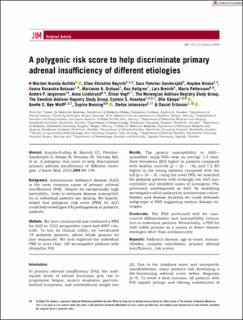| dc.contributor.author | Aranda-Guillén, Maribel | |
| dc.contributor.author | Røyrvik, Ellen Christine | |
| dc.contributor.author | Fletcher-Sandersjöö, Sara | |
| dc.contributor.author | Artaza Alvarez, Haydee Maribel | |
| dc.contributor.author | Botusan, Ileana Ruxandra | |
| dc.contributor.author | Grytaas, Marianne Aardal | |
| dc.contributor.author | Hallgren, Åsa | |
| dc.contributor.author | Breivik, Lars Ertesvåg | |
| dc.contributor.author | Pettersson, Maria | |
| dc.contributor.author | Jørgensen, Anders Palmstrøm | |
| dc.contributor.author | Lindstrand, Anna | |
| dc.contributor.author | Vogt, Elinor Margrethe | |
| dc.contributor.author | Husebye, Eystein Sverre | |
| dc.contributor.author | Kämpe, Olle | |
| dc.contributor.author | Wolff, Anette Susanne Bøe | |
| dc.contributor.author | Bensing, Sophie | |
| dc.contributor.author | Johansson, Stefan | |
| dc.contributor.author | Eriksson, Daniel | |
| dc.date.accessioned | 2023-06-20T11:56:28Z | |
| dc.date.available | 2023-06-20T11:56:28Z | |
| dc.date.created | 2023-06-15T12:58:10Z | |
| dc.date.issued | 2023 | |
| dc.identifier.issn | 0954-6820 | |
| dc.identifier.uri | https://hdl.handle.net/11250/3072292 | |
| dc.description.abstract | Background
Autoimmune Addison's disease (AAD) is the most common cause of primary adrenal insufficiency (PAI). Despite its exceptionally high heritability, tools to estimate disease susceptibility in individual patients are lacking. We hypothesized that polygenic risk score (PRS) for AAD could help investigate PAI pathogenesis in pediatric patients.
Methods
We here constructed and evaluated a PRS for AAD in 1223 seropositive cases and 4097 controls. To test its clinical utility, we reevaluated 18 pediatric patients, whose whole genome we also sequenced. We next explored the individual PRS in more than 120 seronegative patients with idiopathic PAI.
Results
The genetic susceptibility to AAD—quantified using PRS—was on average 1.5 standard deviations (SD) higher in patients compared with healthy controls (p < 2e − 16), and 1.2 SD higher in the young patients compared with the old (p = 3e − 4). Using the novel PRS, we searched for pediatric patients with strikingly low AAD susceptibility and identified cases of monogenic PAI, previously misdiagnosed as AAD. By stratifying seronegative adult patients by autoimmune comorbidities and disease duration we could delineate subgroups of PRS suggesting various disease etiologies.
Conclusions
The PRS performed well for case-control differentiation and susceptibility estimation in individual patients. Remarkably, a PRS for AAD holds promise as a means to detect disease etiologies other than autoimmunity. | en_US |
| dc.language.iso | eng | en_US |
| dc.publisher | Wiley | en_US |
| dc.rights | Navngivelse 4.0 Internasjonal | * |
| dc.rights.uri | http://creativecommons.org/licenses/by/4.0/deed.no | * |
| dc.title | A polygenic risk score to help discriminate primary adrenal insufficiency of different etiologies | en_US |
| dc.type | Journal article | en_US |
| dc.type | Peer reviewed | en_US |
| dc.description.version | publishedVersion | en_US |
| dc.rights.holder | Copyright 2023 The Author(s) | en_US |
| cristin.ispublished | true | |
| cristin.fulltext | original | |
| cristin.qualitycode | 2 | |
| dc.identifier.doi | 10.1111/joim.13649 | |
| dc.identifier.cristin | 2154847 | |
| dc.source.journal | Journal of Internal Medicine | en_US |
| dc.source.pagenumber | 96-109 | en_US |
| dc.identifier.citation | Journal of Internal Medicine. 2023, 294 (1), 96-109. | en_US |
| dc.source.volume | 294 | en_US |
| dc.source.issue | 1 | en_US |

